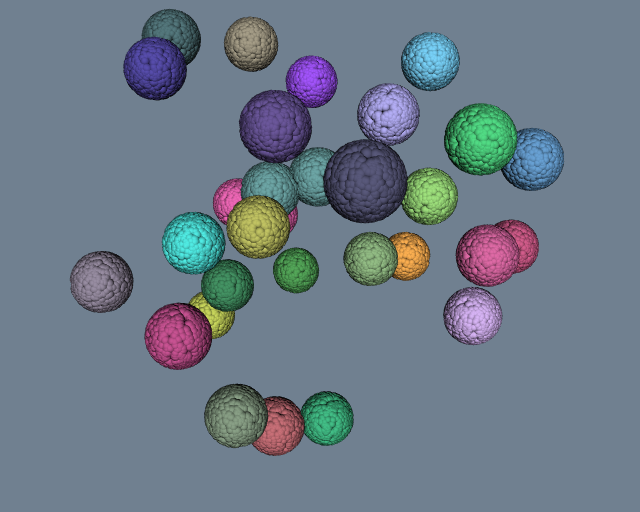ExtractClusters
Repository source: ExtractClusters
Description¶
This example extracts clusters of points. The points lie on spheres that are randomly placed. Each cluster has a different color. The number of extracted clusters may be less that the number of random spheres, if the points on one sphere are within the specified distance of points on another sphere.
Other languages
See (PythonicAPI)
Question
If you have a question about this example, please use the VTK Discourse Forum
Code¶
ExtractClusters.cxx
#include <vtkAppendPolyData.h>
#include <vtkCamera.h>
#include <vtkEuclideanClusterExtraction.h>
#include <vtkGlyph3D.h>
#include <vtkLookupTable.h>
#include <vtkMinimalStandardRandomSequence.h>
#include <vtkNamedColors.h>
#include <vtkNew.h>
#include <vtkPointSource.h>
#include <vtkPolyDataMapper.h>
#include <vtkProperty.h>
#include <vtkRenderWindow.h>
#include <vtkRenderWindowInteractor.h>
#include <vtkRenderer.h>
#include <vtkSphereSource.h>
int main(int, char*[])
{
vtkNew<vtkNamedColors> colors;
vtkNew<vtkMinimalStandardRandomSequence> randomSequence;
// randomSequence->SetSeed(8775070);
randomSequence->SetSeed(4355412);
double limits = 10;
double radius = 0.5;
vtkNew<vtkAppendPolyData> append;
for (unsigned i = 0; i < 30; ++i)
{
vtkNew<vtkPointSource> points;
points->SetNumberOfPoints(800);
points->SetRadius(2.5 * radius);
double x, y, z;
// random position
x = randomSequence->GetRangeValue(-limits, limits);
randomSequence->Next();
y = randomSequence->GetRangeValue(-limits, limits);
randomSequence->Next();
z = randomSequence->GetRangeValue(-limits, limits);
randomSequence->Next();
points->SetCenter(x, y, z);
points->SetDistributionToShell();
append->AddInputConnection(points->GetOutputPort());
}
vtkNew<vtkEuclideanClusterExtraction> cluster;
cluster->SetInputConnection(append->GetOutputPort());
cluster->SetExtractionModeToAllClusters();
cluster->SetRadius(radius);
cluster->ColorClustersOn();
cluster->Update();
std::cout << "Found " << cluster->GetNumberOfExtractedClusters()
<< " clusters within radius " << radius << std::endl;
// Create a lookup table to map point data to colors
vtkNew<vtkLookupTable> lut;
int tableSize = cluster->GetNumberOfExtractedClusters();
lut->SetNumberOfTableValues(tableSize);
lut->Build();
// Fill in the lookup table
for (unsigned int i = 0; static_cast<int>(i) < tableSize; ++i)
{
double r, g, b;
r = randomSequence->GetRangeValue(0.25, 1.0);
randomSequence->Next();
g = randomSequence->GetRangeValue(0.25, 1.0);
randomSequence->Next();
b = randomSequence->GetRangeValue(0.25, 1.0);
randomSequence->Next();
lut->SetTableValue(i, r, g, b, 1.0);
}
vtkNew<vtkSphereSource> sphere;
sphere->SetRadius(radius / 2.0);
vtkNew<vtkGlyph3D> glyphs;
glyphs->SetInputConnection(cluster->GetOutputPort());
glyphs->SetSourceConnection(sphere->GetOutputPort());
glyphs->ScalingOff();
glyphs->Update();
vtkNew<vtkPolyDataMapper> mapper;
mapper->SetInputConnection(glyphs->GetOutputPort());
mapper->SetScalarRange(0, tableSize - 1);
mapper->SetLookupTable(lut);
vtkNew<vtkActor> actor;
actor->SetMapper(mapper);
// Create graphics stuff
//
vtkNew<vtkRenderer> ren1;
ren1->SetBackground(colors->GetColor3d("SlateGray").GetData());
vtkNew<vtkRenderWindow> renWin;
renWin->AddRenderer(ren1);
renWin->SetSize(640, 512);
renWin->SetWindowName("ExtractClusters");
vtkNew<vtkRenderWindowInteractor> iren;
iren->SetRenderWindow(renWin);
// Add the actors to the renderer
//
ren1->AddActor(actor);
// Generate an interesting view
//
ren1->ResetCamera();
ren1->GetActiveCamera()->Azimuth(120);
ren1->GetActiveCamera()->Elevation(30);
ren1->GetActiveCamera()->Dolly(1.5);
ren1->ResetCameraClippingRange();
renWin->Render();
iren->Initialize();
iren->Start();
return EXIT_SUCCESS;
}
CMakeLists.txt¶
cmake_minimum_required(VERSION 3.12 FATAL_ERROR)
project(ExtractClusters)
find_package(VTK COMPONENTS
CommonColor
CommonCore
FiltersCore
FiltersPoints
FiltersSources
InteractionStyle
RenderingContextOpenGL2
RenderingCore
RenderingFreeType
RenderingGL2PSOpenGL2
RenderingOpenGL2
)
if (NOT VTK_FOUND)
message(FATAL_ERROR "ExtractClusters: Unable to find the VTK build folder.")
endif()
# Prevent a "command line is too long" failure in Windows.
set(CMAKE_NINJA_FORCE_RESPONSE_FILE "ON" CACHE BOOL "Force Ninja to use response files.")
add_executable(ExtractClusters MACOSX_BUNDLE ExtractClusters.cxx )
target_link_libraries(ExtractClusters PRIVATE ${VTK_LIBRARIES}
)
# vtk_module_autoinit is needed
vtk_module_autoinit(
TARGETS ExtractClusters
MODULES ${VTK_LIBRARIES}
)
Download and Build ExtractClusters¶
Click here to download ExtractClusters and its CMakeLists.txt file. Once the tarball ExtractClusters.tar has been downloaded and extracted,
cd ExtractClusters/build
If VTK is installed:
cmake ..
If VTK is not installed but compiled on your system, you will need to specify the path to your VTK build:
cmake -DVTK_DIR:PATH=/home/me/vtk_build ..
Build the project:
make
and run it:
./ExtractClusters
WINDOWS USERS
Be sure to add the VTK bin directory to your path. This will resolve the VTK dll's at run time.
